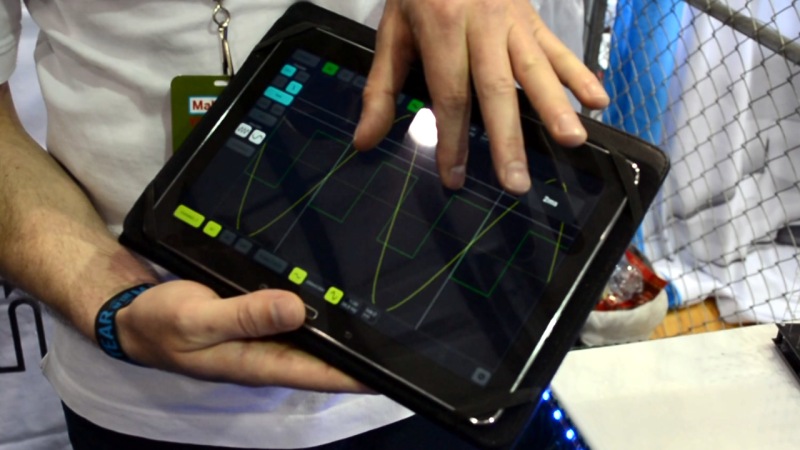[youtube=https://www.youtube.com/watch?v=qEqWtKGJhFQ&w=580]
As most of our readers know, [Mike] was visiting Bay Area Maker Faire last weekend with a big Jolly Wrencher on his back. During his tour he encountered the neat oscilloscope shown in the video above, made by the Belgian company Velleman. Even though it only has a 10MS/s sampling rate and a 10MHz bandwidth, our guess is that it may still be useful for some hobbyists out there as it can communicate with any PC/smartphone/tablet using its Wifi interface.
Inside the black box is a 3.7V 1800mAh Li-ion battery with a USB port to recharge it or update the oscilloscope’s firmware. As seen in the video, the tablet’s touchscreens may enable more natural interaction with the user interface. The protocol used to export the acquired samples is open, which may allow users to create their own analysis program. The oscilloscope uses an 8 bit analog to digital converter and a 4K samples buffer.
















As well all know form the nyquist theorem, one can’t reconstruct a signal with a bandwidth of more than N/2 Hz when sampling at N Hz. Having an input amplifier with more than 5 MHz (more like 3 MHz) would be doing a disservice as higher frequencies would end up aliasing over and resulting in confusing and inaccurate waveforms.
Equivalent time sampling. It’s pretty common particularly in early digitizing scopes that you have a sample rate vs. analog bandwidth that doesn’t obey Nyquist. For example, the Tek 2221a in front of me – 100MHz/100MS/s.
The real point is that you become prone to aliasing, which is for sure a tricky trap to fall in.
For much more very good info from Tek – http://www.tek.com/document/application-note/real-time-versus-equivalent-time-sampling
“There’s not word on”… word on what? Looks like someone hit Post prematurely :P anyone here care to fix?
Well i have a 1Mhz DSO nano and am happy with it even though i have a 20MHz analogue scope too. the only problem i have is that its single channel
Ek hou van jou naam :)
Ja super, genau das interessiert mi!
We are aware of the fact that 10MHz might seem low-spec in the GHz era, but bandwidth is not always the most important factor. It all depends on what you are using it for. There is another important spec which is often forgotten: sensitivity. The WFS210 goes all the way down to 5mV/div, with very low noise. Most low-cost scopes only allow 20 or even 50mV/div.
This could be a perfect first scope for the new generation, provided they price it below $100/100euro
10MHz would be sufficient for some things, mostly for beginners, but it seems like it’s only 1MHz real-time, and many signals can’t be sampled equivalent time because they aren’t sufficiently repetitive.
The best thing about this is the internal battery; as long as you use it without charging at the same time, and using the wifi connection, it’s floating, so there would be no problems with the probe ground being connected to earth (although they would be connected to each other), which means you could safely measure on high voltage systems, as long as the differential voltage is within specifications.
2:40 – I can’t help but laugh. :D I really like the idea behind the product and I value the hard work that has been put into it-and I think it can be great for people starting with electronics, but the moment he says the specs for the (pretty low) bandwidth, the other guy is like-“ARE YOU FRICKIN’ KIDDIN’ ME?! Are we really wasting our time with THAT?” I know it is just a coincidence and he has probably been thinking about something else, but it looks hilarious. :D
It has some uses, audio comes to mind, but also has enormous limitations (errors due to quantization, graphical latency, software interface less usable than a real panel) compared to any 30 years old used analog scope you can snatch on the bay for a fraction of its cost.
You can’t really carry an analogue scope around with you though-although that would be awesome! Makes me wonder if you couldn’t mod the old Sinclair tv into a handheld scope. But sure, I also prefer analog ones. But that moment of silence in the video was just funny.
10MHz – does it come with training wheels?
If the price is right and is has some decent input input attenuators I’d really like this thing. I’ve already got an Rigol, but this thing could be just good enough for the moment’s you don’t want an grounded scope or for debugging those network nodes which are hanging on the ceiling in another room to control my roller blinds. And even If I connect it to my phone it’s got a much higher resolution display than my DS1052E.
It’s probably more fair to compare this velleman thing with something like the dso nano which has a terrible user interface, than with a modern digital scope. I never really understood why they put a lcd on that thing instead of a bluetooth/wifi dongle.
so os this an infomercial for something that is even for sale? or is this open hardware? …yeah i didnt click the video because im here to read :/
Would it kill this wonk to ask how much it costs? Sheesh…
Well it works as advertised but the windows software has no screen save and no
Printing… Also for some reason I could not set the timebase
Incredibly poor software.